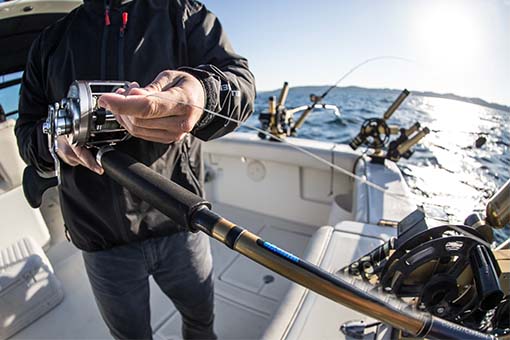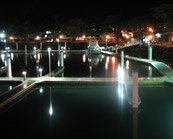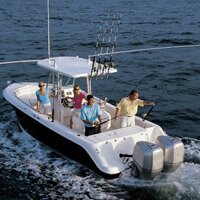Are you ready to head for the deep sea waters and go on the hunt for pelagic beasts? These 10 tips will help make sure your epic voyage is successful.
Saltwater fishing is an exciting endeavor, and nothing is more adrenaline-pumping than heading out to offshore waters for a deep sea fishing adventure. For beginner anglers, however, there’s a lot to learn. Pelagic creatures like marlin and tuna are not easy to fool, and once hooked, they aren’t easy to beat. Ready to go toe to toe with some of the wildest sea creatures on the face of the planet? These 10 deep sea fishing tips for beginners will help make your quest successful.
1. Make sure all your fishing gear is in tip-top condition — after making sure your safety gear is, too. It should go without saying that nicked line, jerky fishing reel drags, and rusty hooks are all impediments to catching fish. And deep sea fishing is such an involved endeavor that most anglers, beginner or expert, are well aware of the fact that they need to make sure all of their gear is perfect condition. Safety gear, however, is also critical to fishing success because nothing will end a fishing trip faster than an accident. So make sure to check out our Boating Safety Guide and do a full safety check before you even address the condition of your rods, reels, and line.
2. Gather all the latest intel. Pelagics move fast, and if your data is a week out of date you could find yourself miles and miles from the nearest fish. Gather intel by asking around on the docks, at the local tackle shop, and checking current reports on the internet like those posted by FishTalk (for the Mid-Atlantic region) or BDOutdoors(for the west coast). Many anglers also like to refer to SST (sea surface temperature) charts to find temperature breaks and plankton concentrations before they ever leave the dock.
3. Look for visible structure. This can include anything floating on the surface of the water, like wood boards, weed paddies, or commercial fishing floats, any of which can concentrate the fish. But it also includes visible color changes which indicate areas where different bodies of water collide, or rips where small standing waves may form. Always remember that the ocean is vast and much of it is like a desert, but any anomaly you spot could give away the life-filled oasis you’re searching for.
4. When you’re not catching fish, be quick to change the pace. If you’re trolling this can mean speeding up or slowing down. If you’re fishing with bait it can mean moving spots or changing the presentation. In a nutshell, if what you’re doing isn’t working don’t stick with it merely because it’s what you heard everyone else does or because the all-knowing internets recommended it.
5. Make the most out of every opportunity by focusing on multiple hook-ups. When it comes to schooling fish, when you get a strike you have two choices: focus solely on landing that one fish, or focus on turning that strike into two strikes. Or three, or four, or more. Instead of diving for the rod, grab a different one and jig it to give the bait additional action. Turn the boat so the other baits pass back over the spot where the fish attacked. And always have a pitch-bait (a pre-rigged line ready to deploy at any moment) prepared, so you can offer it up to any fish that may be following the hooked one. When you find those fish, capitalize on it.
6. Catch what you can. Sometimes people become so focused on catching the “glory fish” like billfish and tuna that they might troll for hours on end without a bite, even though they’ve spotted something like a weedline that may well hold mahi-mahi. Most anglers are happy with a bent rod regardless of what species is providing the tension. So when you see something that you know may hold fish — even if it’s not the declared target species of the day — don’t hesitate to change tactics to get a fish on the line.
7. Use fluorocarbon leaders and ball-bearing swivels. Yes, fluorocarbon costs more. Yes, ball-bearing swivels are more expensive, too. But if you want to be victorious when taking on the creatures of the deep sea environment you need every possible advantage on your side. Fluorocarbon leaders are less visible than other types, and ball-bearing swivels work much better than cheaper barrel swivels. You’ve gone to all the expense and effort to go fishing on the ocean, so don’t cut corners to save a buck on the basics.
8. Book a charter before you set out on your own. A day on a charter boat can produce endless knowledge for rigging, baits, and tactics. And while you may not get the same feeling of satisfaction as you will when you catch a pelagic fish on your own boat, you’ll be able to learn more in a day with a pro than you might learn in a year if left to your own devices.
9. Mark each and every bite on your GPS/chartplotter the moment you get a strike. This will allow you to quickly and accurately navigate right back to the spot where the fish are. Just as importantly, over time you’ll build up a database of productive fishing areas and hotspots.
10. If you’re trolling, learn how to use dredges and teasers. While most professional boats pull these items, many pleasure boats do not. Dredges and teasers are expensive, difficult to deploy, difficult to stow, and add to the chaos when trying to clear lines to land a fish. They also do a great job of attracting predators — so if you want to compete with the big boys offshore, get dredges and teasers and learn how to deploy them in your spread. Will these 10 tips alone make you an expert deep sea angler? Of course not. That will take time and experience, above all else. But pay heed and one thing is for sure: the next time you head offshore, your chances of success will be better than then before.
Read Next: Best Offshore & Deep Sea Fishing Boats


